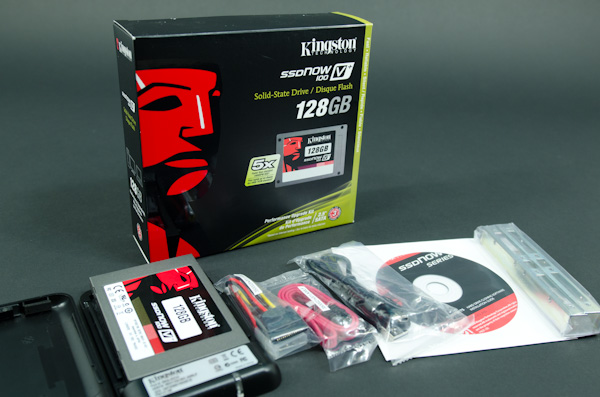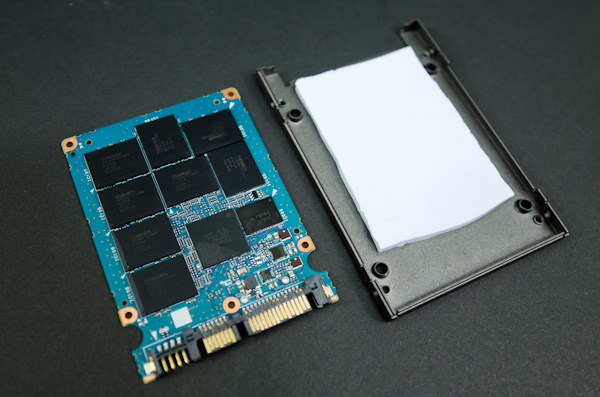Kingston SSDNow V+100 Review
by Anand Lal Shimpi on November 11, 2010 3:05 AM EST- Posted in
- Storage
- SSDs
- Kingston
- SSDNow V+100
Final Words
Kingston, like many of its competitors, desperately needs a simplified product lineup. On the one hand, Kingston has hedged its bets. With three different controller makers supplying hardware for its six SSDs, Kingston can't go wrong. However, the Toshiba powered SSDNow V+ spans the gamut from mediocre random write speed to chart topping performance in some of our workloads. The real world test results are strong enough for me to recommend the drive, however two things don't sit well with me.
First is the price. The V+100 commands a nearly $50 premium over competing SandForce drives. While I can understand paying some premium for Toshiba's name and hopefully reliability, that's a bit much. Compared to the RealSSD C300 the premium is negligible, so the complaint only applies as long as SandForce is in the running.

Kingston sells SSDs as both standalone drives or a part of an upgrade kit
The second issue is the overly aggressive garbage collection. Sequential performance on the V+100 just doesn't change regardless of how much fragmentation you throw at the drive. The drive is quick to clean and keeps performance high as long as it has the free space to do so. This is great for delivering consistent performance, however it doesn't come for free. I am curious to see how the aggressive garbage collection impacts drive lifespan. Kingston ships the V+100 with a 3-year warranty and to Kingston's credit I haven't had any other drives die as a result of wearing out the NAND. Even if the V+100 has higher effective write amplification than the competition, your usage model will determine whether or not you bump into it.
Toshiba is clearly close to knocking this one out of the park. There's a tangible improvement over the original V+ and the drive is clearly doing some things right. The V+100 isn't flawless, but it's finally in the list of drives to consider.
SandForce continues to be the sensible choice, at least in terms of performance per dollar for a boot/application drive. I am careful to mention it as a boot/application drive because if you start storing a lot of incompressible data on the drive (e.g. movies, music, photos) then SandForce quickly loses a lot of its performance advantage. Then you're left with Crucial's RealSSD C300 which delivers more consistent performance regardless of data, at the expense of lower steady state write performance. Without TRIM, the C300 can quickly get into a not-so-great performance situation.
If you don't want a SandForce drive and are running an OS without TRIM support, the V+100 is probably a better option than the C300 thanks to its aggressive garbage collection. I realize this isn't the simplest recommendation, but that's the reality of today's SSD market. There are a lot of great options, but nothing is absolutely perfect.











96 Comments
View All Comments
Gonemad - Thursday, November 11, 2010 - link
Yes, a longevity test. Put it on grind mode until it pops. P51 Mustangs benefited from engines tested that way.Now, this one, should it be fully synthetic or more life like? Just place the drive in "write 0, write 1" until failure, record how many times it can be used, or create some random workload scripted in such a manner that it behaves pretty much like real usage, overusing the first few bytes of every 4k sector... if it affects any results. What am I asking is, will it wear only the used bytes, or the entire 4k rewritten sector will be worn evenly, if I am expressing myself correctly here.
On another comment, I always thought SSD drives were like overpriced undersized Raptors, since they came to be, but damn... I hope fierce competition drive the prices down. Way down. "Neck and neck to mag drives" down.
And what about defragmenting utilities? Don't they lose their sense of purpose on a SSD? Are they blocked from usage, since the best situation you have on a SSD is actually randomly sprayed data, because there is no "needle" running over it at 7200rpm in a forcibly better sequential read? Should they be renamed to "optimization tools" when concerning SSD's? Should anybody ever consider manually giving permission to a system to run garbage collection, TRIM, whatever, while blocking it until strictly necessary, in order to increase life span?
Iketh - Thursday, November 11, 2010 - link
win7 "automatically disables" their built-in defrag for SSDs, though if you go in and manually tell it to defrag an SSD, it will do it without questionprefetch and superfetch are supposedly also disabled automatically when the OS is installed on an SSD, though I don't feel comfortable until i change the values myself in the registry
cwebersd - Thursday, November 11, 2010 - link
I have torture-tested a 50 GB Sandforce-based drive (OWC Mercury Extreme Pro RE) with the goal to destroy it. I stopped writing our semi-random data after 21 days because I grew tired.16.5 TB/d, 360 disk fills/day, 21 days more or less 24/7 duty cycle (we stopped a few times for an hour or two to make adjustments)
~7500 disk fills total, 350 TB written
The drive still performs as good as new, and SMART parameters look reasonably good - to the extent that current tools can interpret them anyway.
If I normally write 20 GB/d this drive is going to outlast me. Actually, I expect it to die from "normal" (for electronics) age-related causes, not flash cells becoming unwritable.
Anand Lal Shimpi - Thursday, November 11, 2010 - link
This is something I've been working on for the past few months. Physically wearing down a drive as quickly as possible is one way to go about it (all of the manufacturers do this) but it's basically impossible to do for real world workloads (like the AT Storage Bench). It would take months on the worst drives, and years on the best ones.There is another way however. Remember NAND should fail predictably, we just need to fill in some of the variables of the equation...
I'm still a month or two away from publishing but if you're buying for longevity, SandForce seems to last the longest, followed by Crucial and then Intel. There's a *sharp* fall off after Intel however. The Indilinx and JMicron stuff, depending on workload, could fail within 3 - 5 years. Again it's entirely dependent on workload, if all you're doing is browsing the web even a JMF618 drive can last a decade. If you're running a workload full of 4KB random writes across the entire drive constantly, the 618 will be dead in less than 2 years.
Take care,
Anand
Greg512 - Thursday, November 11, 2010 - link
Wow, I would have expected Intel to last the longest. I am going to purchase an ssd and longevity is one of my main concerns. In fact, longevity is the main reason I have not yet bought a Sandforce drive. Well, I guess that is what happens when you make assumptions. Looking forward to the article!JohnBooty - Saturday, November 13, 2010 - link
Awesome news. Looking forward to that article.A torture test like that is going to sell a LOT of SSDs, Anand. Because right now that's the only thing keeping businesses and a lot of "power users" from adopting them - "but won't they wear out soon?"
That was the exact question I got when trying to get my boss to buy me one. Though I was eventually able to convince him. :)
Out of Box Experience - Thursday, November 11, 2010 - link
Here's the problemSynthetic Benchmarks won't show you how fast the various SSD controllers handle uncompressible data
Only a copy and paste of several hundred megabytes to and from the same drive under XP will show you what SSD's will do under actual load
First off, due to Windows 7's caching scheme, ALL drives (Slow or Fast) seem to finish a copy and paste in the same amount of time and cannot be used for this test
In a worst case scenario, using an ATOM computer with Windows XP and Zero SSD Tweaks, a OCZ VERTEX 2 will copy and paste data at only 3.6 Megabytes per second
A 5400RPM laptop drive was faster than the Vertex 2 in this test because OCZ drives require massive amounts of Tweaking and highly compressible data to get the numbers they are advertizing
A 7200RPM desktop drive was A LOT faster than the Vertex 2 in this type of test
Anyone working with uncompressible data "already on the drive" such as video editors should avoid Sandforce SSD's and stick with the much faster desktop platter drives
Using a slower ATOM computer for these tests will amplify the difference between slower and faster drives and give you a better idea of the "Relative" speed difference between drives
You should use this test for ALL SSD's and compare the results to common hard drives so that end users can get a feel for the "Actual" throughput of these drives on uncompressible data
Remember, Data on the Vertex drive's is already compressed and cannot be compressed again during a copy/paste to show you the actual throughput of the drive under XP
Worst case scenario testing under XP is the way to go with SSD's to see what they will really do under actual workloads without endless tweaking and without getting bogus results due to Windows 7's caching scheme
Anand Lal Shimpi - Friday, November 12, 2010 - link
The issue with Windows XP vs. Windows 7 doesn't have anything to do with actual load, it has to do with alignment.Controllers designed with modern OSes in mind (Windows 7, OS X 10.5/10.6) in mind (C300, SandForce) are optimized for 4K aligned transfers. By default, Windows XP isn't 4K aligned and thus performance suffers. See here:
http://www.anandtech.com/show/2944/10
If you want the best out of box XP performance for incompressible data, Intel's X25-M G2 is likely the best candidate. The G1/G2 controllers are alignment agnostic and will always deliver the same performance regardless of partition alignment. Intel's controller was designed to go after large corporate sales and, at the time it was designed, many of those companies were still on XP.
Take care,
Anand
Out of Box Experience - Saturday, November 13, 2010 - link
Thanks AnandThats good to know
With so many XP machines out there for the foreseeable future, I would think more SSD manufacturers would target the XP market with alignment agnostic controllers instead of making the consumers jump through all these hoops to get reasonable XP performance from their SSD's
Last question..
Would OS agnostic garbage collection like that on the new Kingston SSD work with Sandforce controllers if the manufacturers chose to include it in firmware or is it irrelevant with Duraclass ?
I still think SSD's should be plug and play on ALL operating Systems
Personally, I'd rather just use the drives instead of spending all this time tweaking them
sheh - Thursday, November 11, 2010 - link
This seems like a worrying trend, though time will tell how reliable SSDs are long-term. What's the situation with 2Xnm? And where does SLC fit into all that regarding reliability, performance, pricing, market usage trends?